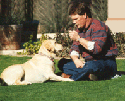 |
|||
|
|
 |
 |
|
|
 |
|||||
|
Beauty is only Skin Deep - My wife's family has owned boxers for over 50 years. When we first got married she told me that all of their boxers weighed over 100 pounds -- I humored her. Boxers aren't supposed to weigh 100 pounds. When the family bought a boxer puppy several years ago it was my wife's turn to humor me. Tyson grew up to weigh over 100 pounds - none of it fat. I stand corrected; some boxers don't match the standard for the breed. There is a common belief that dogs of a common breed are almost identical. We often make decisions about the type of dog to buy, based on our experiences with similar looking animals. If we have always lived with friendly German Shepherds we will assume that the next one we see will also be friendly. To carry it one step further, if we have grown up with Malamutes we may automatically like Akitas because the have a similar appearance. This is not necessarily a wise leap of faith. Just because two animals look the same they may not necessarily behave the same. Scientific studies of dog genetics have yielded an interesting view of this issue. First, while puppies of a given breed may look almost exactly alike, there can be wide behavioral differences between individuals within a single litter. There can also be great differences between animals who have the same parents, but were from subsequent litters. The millions of combinations of genes possible to two individuals are not even remotely displayed within a single litter. Simply because an animal has a fine pedigree does not mean the animal is automatically healthy or behaviorally sound. One of the difficulties with the breed system is that the criteria for breeding are often misguided. A scientific study by Drs. John Scott and John Fuller demonstrated that the genes responsible for color are not connected to behavior, yet countless pet owners differentiate between black, yellow and chocolate Labrador retrievers. Some breeders try to breed exclusively for one color and ignore potentially harmful traits - as long as the puppy is brown! This attitude is mirrored in the way animals are judged at dog shows. Some judges develop preferences based on purely cosmetic features. While they are not supposed to, some judges invariably pick blonde Golden retrievers over red ones, or heavier coated Norwegian Elkhounds over short coated. Ironically, other breeds, like collies and dachshunds, are judged separately if their coats are of dissimilar length, color or texture. This ambiguity leads to breeding animals for cosmetic reasons rather than for health and behavioral soundness. Another study of the differences between breeds further complicated the matter. Dr. Joe Templeton of Texas A&M University, said in a March, 1990, Atlantic Monthly interview, "Right now, looking at chromosomes and genetic fingerprinting, we cannot distinguish between breeds. In fact, in a comparison of two American Staffordshire Terriers with a Whippet, one terrier appeared more closely related to the whippet than the other terrier. " Using an inaccurate method for classifying breeding stock can lead to devastating side effects. The breed standards for Dalmatians calls for disqualification of dogs that have any colors other than either white with black spots, or white with liver colored spots. If a three colored Dalmatian was born that was absolutely free from nerve deafness (a disease common to Dalmatians) it would be eliminated from the gene pool. A dog that had the correct spot pattern would probably be retained even though it carried the genes for deafness. Though the physical appearance of the animal is a poor indicator of its genetic value, it is still the real underlying standard for purebreds. If you are looking for a pet, the easiest way to select the animal is to choose it based solely on its appearance. While this is convenient, it may also lead to unexpected consequences. If you select a pet based on image rather than substance, be prepared to find out the hard way - beauty may only be skin deep.
|
|||||
|
Copyright 1991-2008 Gary Wilkes - All rights reserved. No portion of this website may be reproduced without permission. For questions regarding reprinting articles and copyright, contact Gary Wilkes at wilkesgm@aol.com |
|||||
|
Copyright 1994-2013 Gary Wilkes. All rights reserved.
|
|||||

